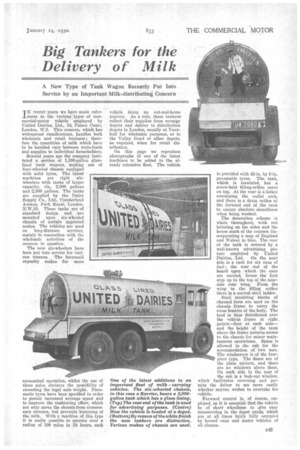Big Tankers for the
Page 65

If you've noticed an error in this article please click here to report it so we can fix it.
Delivery of Milk
A New Type of Tank Wagon Recently Put Into Service by an Important Milk-distributing Concern• IN recent -years we have made references to the various types of coramercial-motor vehicle employed by United Dairies, Ltd., 34, Palace Court, London, W.2. This concern, which has widespread ramifications, handles both wholesale and retail business ; therefore the quantities of milk which have to be handled vary between train-loads and supplies to individual householders.
Several years ago the company instituted a service of 1,300-gallon glasslined tank wagons, making use of four-wheeled chassis equipped with solid tyres. The latest machines are rigid sixwheelers with tanks of larger capacity, viz., 2,000 gallons and 2,500 gallons. The tanks are supplied by the Dairy Supply Co., Ltd., Cumberland Avenue, Park Royal, London, N.W.10. These tanks are of standard design and are mounted upon six-wheeled chassis of certain approved makes. The vehicles are used on long-distance services, mainly in connection with the wholesale activities of the concern in question.
The new six-wheelers have been put into service for various reasons. The increased capacity makes for more
economical operation, whilst the use of three axles obviates the possibility of exceeding the legal axle weight. Pneumatic tyres have been specified in order to permit increased average speed and to improve the cushioning effect, which not only saves the chassis from unnecessary stresses, but prevents buttering of the milk. With a machine of this type it is easily possible to operate over a radius of 100 miles in 24 hours, each
vehicle doing an out-and-home journey. As a rule, these tankerscollect their supplies from county depots and deliver to distribution depots in London, usually at Vauxhall for wholesale purposes, or to the Valley Road or other depots, as required, when for retail distribution.
On this page we reproduce photographs of one of the latest machines to be added to the already extensive fleet, The vehicle
One of the latest additions to an important fleet of milk carrying vehicles. The laicwheeled chassis, in this case a Karrier, bears a 2,000gallon tank which has a glass lining. (Top) The rear end of the tank is used for advertising purposes. (Centre) How the vehicle is loaded at a depot. (Bottom)By reason of the white finish the new tankers are distinctive. Various makes of chassis are used. is provided with 42-in. by 9-in. pneumatic tyres. The tank, which is insulated, has a screw-held filling-orilice cover on top. At the rear is a locker containing the outlet cock, and there is a drain orifice at the forward end of the tank to ensure absolute cleanliness when being washed.
The decoration scheme is white throughout, with red lettering on the sides and the house mark of the concern (incorporating a map of England and Wales) in blue. The rear of the tankis covered by a well-known advertising picture employed by United Dairies, Ltd. On the near aide is a rack for six cans of fuel; the rear end of the board upon . which the cans are carried, forms the first step up to the top of the nearside rear wing. From the wing to the filling orifice there is a curved steel ladder. Steel mounting blocks of channel form are used on the chassis frame to carry the cross bearers of the body. The load is thus distributed over the vehicle frame at eight points—four at each side— and the height of the tank above the frame permits access to the chassis for minor maintenance operations. Space is allowed in the cab for the accommodation of two men. The windscreen is of the fourpiece type. The doors are of the plain pattern, and there are no windows above them. On each side in the rear of the cab is a look-out window, which facilitates reversing and permits the driver to see more easily whether anyone wishes to overtake his vehicle.
Forward control is, of course, employed, as it is essential that the vehicle be of short wheelbase to give easy manoeuvring in the depot yards, which are at all times fairly fully occupied by horsed vans and motor vehicles of all classes,












































































































